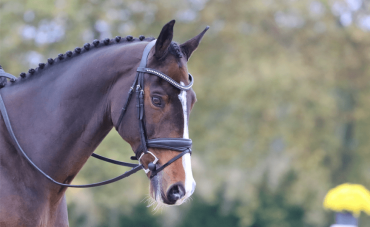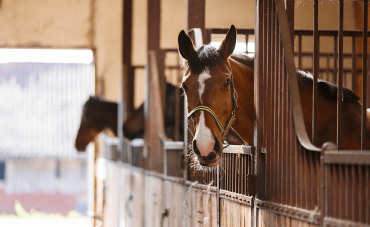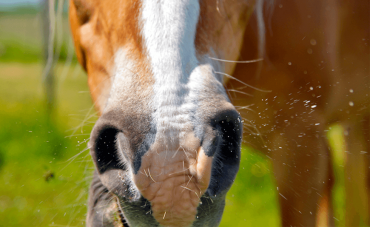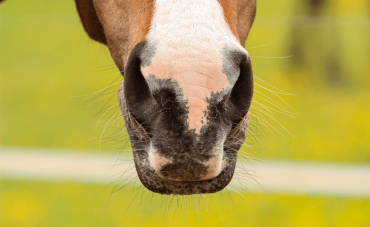Tendonitis stands as one of the most prevalent musculoskeletal disorders afflicting horses. Apart from causing discomfort and pain, tendonitis can also hamper your horse's sporting career. In this article, we will delve into this condition, examining its origins, symptoms, and treatment.
What is tendonitis
in horses?
Tendons consist of solid, smooth fibres that connect muscles to bones, facilitating joint movement by transferring the force of the horse's muscles to the bones. Horses have four primary tendons in their limbs: two extensor tendons and two flexor tendons.

These tendons are constructed from collagen fibres that unite to create elastic fibres.

Tendonitis is characterised by inflammation of a tendon, leading to varying degrees of damage to the collagen fibres that constitute tendons.
Different types of tendonitis can be defined based on the extent of damage to these fibres:
- Early Tendonitis: In this stage, the fibres sustain minor damage, and the horse may experience minimal or no lameness.
- Acute Tendonitis: The fibres are moderately to severely damaged, often resulting in noticeable lameness, the severity of which correlates with fibre damage.
- Chronic Tendonitis: This phase occurs when acute tendonitis does not heal correctly. While the fibres are less damaged than in acute tendonitis, their function is limited due to poor healing, sometimes leading to fibrosis. Horses may not exhibit prominent lameness but can experience discomfort in movement.
Tendonitis primarily affects active horses whose tendons endure significant stress. It is estimated that approximately 35% of active horses have experienced tendonitis. This injury ranks as the second most common reason for horses retiring from sports. However, when treated correctly, with a thorough understanding of the condition, tendonitis can be cured.
Causes of tendonitis
in horses
The leading cause of tendonitis in horses is work. However, it is not work alone that triggers this condition; rather, it is work combined with various risk factors that increase the likelihood of tendonitis.
Key risk factors include:
- The Horse's Leg Conformation: Horses with poor leg conformation, such as knock-knees or splayfoot, are at a higher risk of tendonitis due to increased tendon stress.
- Shoeing/Trimming: Improper shoeing or trimming, which is not adapted to the horse or their activity, can exert excessive pressure on the tendons.
- Soil Quality: Working a horse on excessively soft ground can overstress their tendons, causing the fetlock to hyperextend, impacting the flexor tendons.
- The Horse's Weight: Similar to musculoskeletal disorders like arthritis, excess weight places greater stress on the tendons.
- The Horse's Training: Overly intense training can lead to overstressing of specific tendons.
- The Horse's Age: As horses age, their tendons tend to deteriorate, rendering them more fragile.
- Inadequate Protections: Poorly positioned bandages can make tendons more vulnerable.
While tendonitis is frequently associated with work and risk factors, it can also result from accidents causing a clean break in the tendon, such as an accident involving a fence.
Symptoms of tendonitis in horses
As with many medical conditions, the symptoms of tendonitis in horses can vary significantly. These symptoms and their severity are linked to the seriousness of the horse's tendonitis.
Tendonitis occurs when a tendon becomes inflamed. Over 70% of horse owners have likely observed signs of inflammation, such as as soft swellings, heat, or swelling in the tendons, without associated lameness. These are the initial symptoms of tendonitis. These subtle symptoms manifest in the early stages of tendonitis in horses, referred to as the subclinical stage. During this phase, the tendon becomes inflamed, and without intervention, it may deteriorate, causing more extensive damage to the fibres.

If the tendonitis worsens, it advances to the clinical stage, with more pronounced and significant symptoms related to severe tendon fibre damage. One noticeable symptom is lameness, which tends to be more pronounced in horses working on soft surfaces, where the tendons experience greater stress. However, the severity of lameness may vary depending on the extent of tendon damage.
Another symptom is localised deformation in the area of the affected tendon, often appearing as a banana-shaped swelling, reflecting the inflammation of the tendon. This region is typically warm and tender, and a soft tumour may develop on the tendon. Horses may also alleviate their pain by positioning the affected limb in front of the other.

Diagnosing tendonitis
in horses
If you suspect that your horse is displaying signs of tendonitis, it is essential to promptly contact your vet for a diagnosis.
To initiate the diagnosis, the vet will perform a three-stage clinical examination:
- Observation of the horse at rest to assess leg conformation and identify potential deformities.
- Palpation of the horse's limbs to detect areas that are warmer or more sensitive.
- Evaluation of the horse's movement on different surfaces to identify any lameness.
Following the clinical examination, your vet may recommend an ultrasound to visualise the tendons and precisely pinpoint the location and severity of tendonitis, thus refining the diagnosis and treatment plan.
The tendons most frequently affected in horses are the deep digital flexor tendon (perforans tendon) and the superficial digital flexor tendon (perforatus tendon). Damage to specific ligaments with a role similar to tendons, such as the fetlock suspensory ligament, is also common.
Treating tendonitis
in horses
Upon diagnosing the condition, your vet will propose a tailored treatment regime for your horse. When it comes to tendonitis in horses, allowing the tendon to rest is vital for its recovery. The recommended duration and strictness of the resting period depend on the horse and the severity of their tendonitis. The resting period can range from a few days, in cases of minor inflammation, to several months if the fibres are damaged. Some horses will remain stabled during this period, while others may stay in the field, engage in light activity, or even continue to work.
While resting is a critical component of tendonitis treatment, it is often not sufficient on its own. Your vet will suggest other treatments tailored to your horse's needs. These treatments may include:
Medication:
- Oral, injectable or external-application gel anti-inflammatories can limit inflammation in the horse’s tendon and therefore reduce pain. Though inflammation is useful as part of healing, it must be controlled in order to avoid any harmful effects.
- Regenerative medicine is also available which can be used via injection into the tendons. PRP (platelet-rich plasma) is another option which stimulates the synthesis of type-I collagen (the collagen that makes up 80% of tendon fibres), or the use of stem cells.
Shoeing/trimming:
- Proper care of a horse's feet is crucial in treating tendonitis. Adjustments to shoeing or trimming may be necessary during the healing process and return to work. Collaboration between your farrier and vet will ensure the best solution for your horse.
Other Treatments:
- Re-education methods have gained prominence in recent years. Follow-up from an osteopath or masseur can aid in the horse's recovery.
- Laser or shockwave treatments are also popular options and can be recommended by your vet.
Nutritional Supplements:
- Supplements such as Ekyflex Tendon Evo, containing essential elements for high-quality collagen production, can be beneficial during the recovery process.
Return to Work:
While strict rest is initially crucial for treating tendonitis, your horse's return to work must be gradual.
Your vet will provide guidance on a phased return-to-work plan, typically comprising the following stages:
- Walking the horse on firm ground for short durations.
- Alternating between walking and trotting on solid ground, gradually increasing the duration of trotting phases and total outing duration.
- Progressive reintroduction of galloping on stable ground.
- Gradual resumption of normal work.
The duration of each of these phases will depend on your horse, and your vet will be able to help and advise you. If your vet gives you a strict regime, we recommend that you follow it. Even if your horse is not limping and seems comfortable, the healing and consolidation of the tendon’s fibres takes time and returning to work too quickly may cause rapid relapse.
In any case, when getting your horse back on the road and in order to avoid relapse, it’s important to avoid working your horse on overly deep soil.
Preventing tendonitis
in horses
To prevent tendonitis in your horse or reduce the risk of recurrence, consider implementing these everyday practices:
- Opt for quality ground surfaces that are not too soft, preventing your horse's feet from sinking too deeply to avoid overstressing tendons. It's important to strike a balance between ground flexibility and hardness.
- Monitor your horse's weight closely. Excessive weight increases the load on their limbs and tendons, elevating the risk of damage.
- Be vigilant for signs of tendon inflammation, such as swelling or heat in the tendons after exercise. Occasional inflammation can be managed with cold water showers and, if necessary, clay applications. However, persistent issues should prompt you to consult your vet for timely treatment.
- During periods of increased stress on your horse's tendons, like competitions or intense work, consider using food supplements such as Ekyflex Tendon EVO to safeguard your horse's tendons and prevent damage.
In conclusion, while tendonitis in horses is a treatable and manageable condition, it impacts a substantial number of horses and should not be taken lightly. Whenever in doubt, consult your vet for guidance on tailored solutions for your horse. If you have any questions, feel free to reach out to us via our social media channels.










